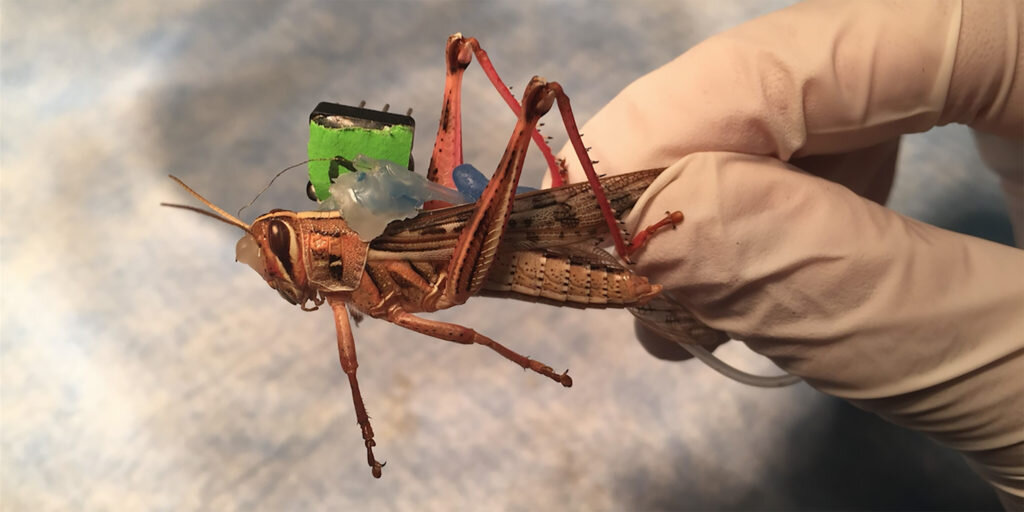
The year was 2016 and the headlines talked about something called cyborg insects and reflected on a branch of technology called biorobotics.
Washington University in St. Louis has made news with their research efforts to use cyborg insects as biorobotic sensing machines. Translation: University engineers wanted to see if they could capitalize on the sense of smell in locusts for sensing systems that could be used by such departments as homeland security.
Barani Raman, an associate professor at the Washington University's biomedical engineering, and his team have been studying how sensory signals are received and processed in locusts' brains. Fundamental olfactory processing in grasshoppers was in the spotlight; Raman focused on how sensory signals are received and processed in their relatively simple brains and his team fashioned a cyborg sniffer.
Fast forward from 2016 to Monday. New Scientist reported that cyborg grasshoppers have been engineered to sniff out explosives.
How the system works: Bomb-sniffing grasshoppers are kitted out with backpacks. They are engineered to transmit data to reveal explosive chemicals. The signals are transmitted wirelessly to a computer from their attached backpacks.
Again, it was Prof. Raman and colleagues at Washington University in St. Louis, featured this time for having tapped into "the olfactory senses of the Schistocerca americana, to create bomb sniffers, uniting sensors of a grasshopper with electronics. Donna Lu reported in New Scientist that these tiny lightweight sensor backpacks fitted to the grasshoppers "were able to record and wirelessly transmit the electrical activity almost instantaneously to a computer."
What gives insects a special edge on sniffing out dangerous systems?
New Scientist: Consider olfactory receptor neurons in the antennae. They pick up on chemical odors in the air. They send electrical signals to a part of the insect brain known as the antennal lobe. Each grasshopper antenna has approximately 50,000 of these neurons.
In their testing, the team implanted tiny electrodes into the insects' antennal lobes and puffed vapors of different explosive materials. The non-explosive controls were hot air and benzaldehyde. Vapors of different explosive materials puffed into the antennae included TNT and DNT.
"The last step was to fit grasshoppers with a sensor 'backpack' which would record and transmit their neural activity in real-time to a computer, where it would be interpreted," said ZME Science.
What were the test results? Recordings of neural activity from seven grasshoppers were around 80 percent accurate,
"The grasshoppers' brains continued to successfully detect explosives up to seven hours after the researchers implanted the electrodes, before they became fatigued and ultimately died," said Lu.
Not only that, and also impressive: "The grasshoppers were able to detect where the highest concentration of explosives was when the team moved the platform to different locations," said New Scientist.
The paper "Explosive sensing with insect-based biorobots" is up on the preprint server bioRxiv. The authors stated that "We demonstrate a bio-robotic chemical sensing approach where signals from an insect brain are directly utilized to detect and distinguish various explosive chemical vapors."
They said in their paper that they believed their approach was not that different from the 'canary in a coal mine' approach, "where the viability of the entire organism is used as an indicator of absence/presence of toxic gases."
More information: Debajit Saha et al. Explosive sensing with insect-based biorobots, biorxiv (2020). DOI: 10.1101/2020.02.10.940866
© 2020 Science X Network
Citation: Researchers use grasshoppers to detect explosive chemical vapors (2020, February 18) retrieved 18 February 2020 from https://techxplore.com/news/2020-02-grasshoppers-explosive-chemical-vapors.html
This document is subject to copyright. Apart from any fair dealing for the purpose of private study or research, no part may be reproduced without the written permission. The content is provided for information purposes only.
